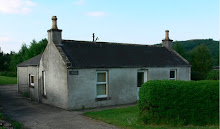 This blog will likely continue until the burial of the butt (barrel) at the end of the month, but this will be last post from the highlands. We had our final dinner tonight, which was nice, though it's very sad to be leaving. Jin and I drive to the airport tomorrow morning together and Ming leaves the following day. I found out tonight that his wife is expecting their first child, who was conceived in the cottage next to the castle, several weeks back. Martina will be gone by the time I return late September.
This blog will likely continue until the burial of the butt (barrel) at the end of the month, but this will be last post from the highlands. We had our final dinner tonight, which was nice, though it's very sad to be leaving. Jin and I drive to the airport tomorrow morning together and Ming leaves the following day. I found out tonight that his wife is expecting their first child, who was conceived in the cottage next to the castle, several weeks back. Martina will be gone by the time I return late September. I will miss Andy most of all. Every aspect of the residency program here is fantastic, but his hospitality, knowledge, wit, etc. etc. elevates the experience to something truly memorable. I can't imagine negotiating my project with anyone other than him. He deserves a big fuckin' vacation at the end of all this.
I tend to sneak out the back door because I dislike goodbyes, so I'm gonna cheat here on my last day and quote from Kristin Hersh's blog from last week, about leaving Edinburgh:
"......This is not enough time to be in Scotland. Not enough time to love everyone we meet, not enough time to watch gorgeous dogs run on the green, not enough time to drink tea as strong as whisky and whisky as strong as god, not enough time to breathe clean meadow air, not enough time to gawk at real-actual-gazillion-year-old-no-fucking-kidding castles......"














































